Top ‘a da World, Ma! Climbing St. Peter's Dom
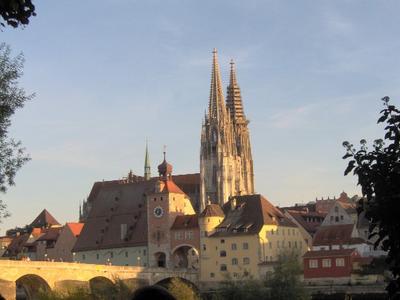 Thursday we MSU Regensburgers has an opportunity afforded very few—we ascended St. Peter’s Dom (Cathedral), one of Germany’s two gothic cathedrals. The other and best known is Cologne’s whose 515 foot spires made it the tallest structure in the world until 1889 when Alexandre Gustave Eiffel erected his tower in Paris. The Regensburg Dom towers are said to be modeled on Cologne’s although to me their design seems inspired to the canopies over the various naves inside the Dom.
Thursday we MSU Regensburgers has an opportunity afforded very few—we ascended St. Peter’s Dom (Cathedral), one of Germany’s two gothic cathedrals. The other and best known is Cologne’s whose 515 foot spires made it the tallest structure in the world until 1889 when Alexandre Gustave Eiffel erected his tower in Paris. The Regensburg Dom towers are said to be modeled on Cologne’s although to me their design seems inspired to the canopies over the various naves inside the Dom.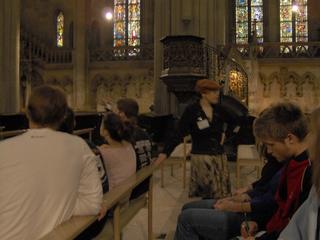 The outing was part of the art history class taught by Kristine Andrea, but all were invited and most came. The day of the ascent we began in the restoration shop where craftsmen work in the old ways with the old tools to restore those parts of the sandstone structure deteriorated over the centuries by weather and pollution.
The outing was part of the art history class taught by Kristine Andrea, but all were invited and most came. The day of the ascent we began in the restoration shop where craftsmen work in the old ways with the old tools to restore those parts of the sandstone structure deteriorated over the centuries by weather and pollution.

There she continued her lecture on Gothic architecture from the previous class. The Gothic style originated in France in 1136 as a transition from the Romanesque first seen in the church of St. Denis whose designer introduced the innovations of spires and the rose window, the latter sparingly used because too many windows would weaken the massive walls need to support the building’s weight. The desire to bring more light to church interiors led to the innovation known as the flying buttress that transferred the weight of the structure though it to the ground permitting the wall to be opened to hold huge stained glass windows. The characteristic spire was added to the buttress to increase its weight and stability.
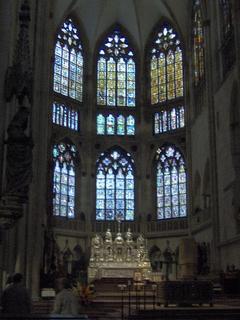
The term Gothic was not applied until the mid-16th century when Giorgio Vasari, a student of Michelangelo, employed it to denigrate the style as "heaps of spires, pinnacles, and grotesque decorations lacking in all the simple beauty of the classical orders." When gothic went out of fashion, those who came after attempted to minimize what they thought were its excesses, stripping the interior stone work of it color to mimic what they believed was the classical style of Greece and Rome (not knowing, as modern art historians do that columns and interiors of Greek and Roman temples were also brightly painted).
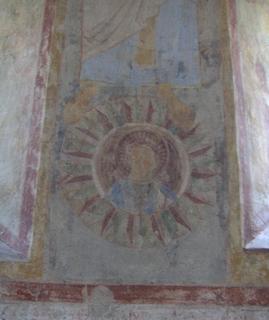
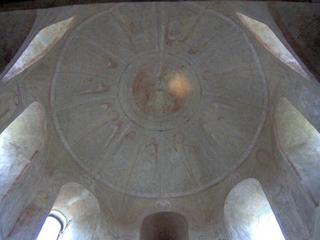
In the 19th century came a neo-gothic revival at which time the Regensburg Dom finally got its towers and replacement widows for those destroyed by previous generations—not windows of stained glass, however, but of painted glass with a geometric panels completely foreign (and inferior) to the almost psychedelic complexity of the gothic .
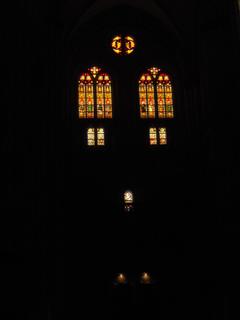
The climb started in the donkey tower, a structure that takes its name from the crane (or donkey) atop it that was used (and is still used) to raise large blocks of cut stone and statuary to the top of the Dom. There are no stairs but a tight winding ramp that brings one, dizzied, to an attic space above the cathedral where is a huge wheel in which workers would walk to power the winch that raised the stone by the donkey crane. Of course upon being informed of this arcane piece of medieval building lore, everyone had to take his or her turn as human hamsters trending in the wheel.
 From there we winded our way along the narrow ledge of the Dom roof to reach the platform
From there we winded our way along the narrow ledge of the Dom roof to reach the platform 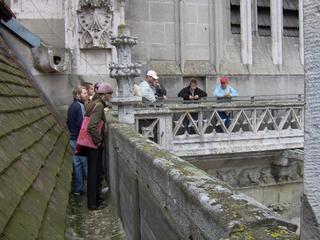 between the two spires, which the highest point one can reach with ropes and climbing harness.
between the two spires, which the highest point one can reach with ropes and climbing harness. 
The view over the city was spectacular despite the overcast sky. 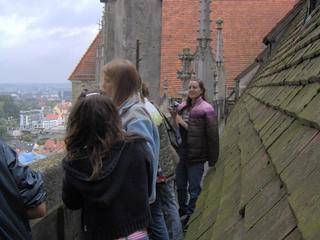

But even more impressive, for me at least, was that I was able to see close up what very few people will ever see, sculptures done with as much care and artistry as those inside the Dom—poignant statements that the work’s the thing, not done for human admiration but as an offering to God.
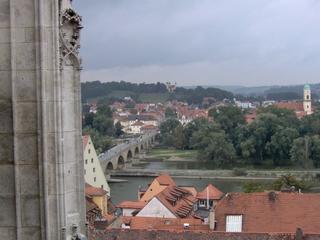



0 Comments:
Post a Comment
<< Home